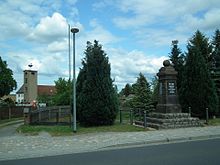Whitewash
| coat of arms | Germany map | |
|---|---|---|
 Help on coat of arms |
Coordinates: 51 ° 29 ' N , 14 ° 43' E |
|
| Basic data | ||
| State : | Saxony | |
| County : | Goerlitz | |
| Management Community : | White water | |
| Height : | 126 m above sea level NHN | |
| Area : | 50.68 km 2 | |
| Residents: | 1284 (Dec. 31, 2019) | |
| Population density : | 25 inhabitants per km 2 | |
| Postal code : | 02957 | |
| Area code : | 03576 | |
| License plate : | GR, LÖB, NOL, NY, WSW, ZI | |
| Community key : | 14 6 26 590 | |
| Community structure: | 2 parts of the community | |
| Association administration address: | Marktplatz 02943 Weißwasser |
|
| Website : | ||
| Mayor : | Andreas Lysk | |
| Location of the community Weißkeißel in the district of Görlitz | ||
Weißkeißel , Upper Sorbian , is a municipality in the district of Görlitz in the east of the Free State of Saxony . The place originally belonged to the Sorbian language area of the Muskau dialect and is still part of the official Sorbian settlement area .
Geography and traffic
The municipality of Weißkeißel is located in the northeastern part of the district near the border with Poland in a wooded area on the northern edge of the Muskauer Heide . The Upper Lusatia military training area extends south of the settlement area and , at around 160 km², is the fourth largest military training area for the Bundeswehr .
To the northwest of Weißkeißel lies the town of Weißwasser , about 7 km away , with which Weißkeißel forms an administrative community . The municipality of Krauschwitz , the eponymous capital of which is north of Weißkissel, occupies the entire eastern border. The municipality of Rietschen borders in the south and the municipality of Boxberg / OL in the southwest .
The federal highway 115 runs through the municipality, which leads from Bad Muskau via Krauschwitz, Weißkeißel and Rietschen to Niesky and Görlitz and forms one of the main arteries of the northern district.
There is a Deutsche Bahn AG depot on the Berlin – Görlitz railway line , which is remote and is only designed for operational purposes. The rail connection to the systems of the military training area is also served from there. It is manned locally by a dispatcher .
history
Weißkeißel was first mentioned in a document on September 21, 1452, when Wenzel von Bieberstein granted the town of Muskau city rights. The village had 32 souls and was called Weißkesch . The spelling changed several times over the course of time, mostly several conceptions were valid at the same time - from Weiszkeusel to Weißkhessel and Weißkeisel to the final decision in the first half of the 20th century to officially use the Weißkeißel spelling, although the Weißkeisel spelling was still used on some entrance signs existed until 1987.
Due to its location, Weißkeißel's history is closely linked to the history of the Muskau class . During the Thirty Years War , Weißkeißel was destroyed by imperial troops in 1631.
Until the 20th century, a large part of the population spoke Sorbian . Arnošt Muka determined for his statistics of the Lusatian Sorbs 1884/85 a total population of 755, of which 739 Sorbs (98%) and 16 Germans.
In the German Democratic Republic , Weißkeißel became the location for the land forces of the NVA with the training center 6 ("Rudolf Egelhofer"), the rocket department 6 ("Ernst Busch"), and the Nochten military training area .
politics
Since the municipal council election on May 26, 2019 , the 12 seats of the municipal council have been distributed among the individual groups as follows:
mayor
Andreas Lysk was re-elected on June 7, 2015.
Local division
In addition to Weißkeißel itself, the settlements Haide ( Hola ) , Kaupen ( Kupelń ) and Bresina ( Brězyna ) belong to the municipality, with only Haide having the status of a part of the municipality . The communities Weißkeißel and Haide had been working together since 1960, but the merger did not take place until January 1, 1974.
Attractions
The cultural monuments are recorded in the list of cultural monuments in Weißkeißel .
Regular events
In Weißkeißel there is a monthly farmers and livestock market with regional awareness. The witch burning in Weißkeißel on April 30th was of national importance for many years . It was the largest folk festival in Weißkeißels and the largest witch's burn in the region around Weißwasser . However, since 2011 it has not been carried out on a large scale for various reasons. Therefore it had to give this title to the Witches Burn in Weißwasser.
literature
- From the Muskauer Heide to the Rotstein. Home book of the Lower Silesian Upper Lusatia District . Lusatia Verlag, Bautzen 2006, ISBN 978-3-929091-96-0 , p. 236 .
Individual evidence
- ↑ Population of the Free State of Saxony by municipalities on December 31, 2019 ( help on this ).
- ↑ Saxon Sorbs Act , Annex to Section 3 (2)
- ↑ Ernst Tschernik: The development of the Sorbian population . Akademie-Verlag, Berlin 1954, p. 122 .
- ↑ Results of the 2019 municipal council elections
- ↑ https://www.statistik.sachsen.de/wpr_alt/pkg_s10_bmlr.prc_erg_bm_a?p_bz_bzid=BM151&p_ebene=GE&p_ort=14626590
Web links
- Weißkeißel community
- Weißkeißel in the Digital Historical Directory of Saxony





